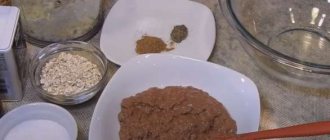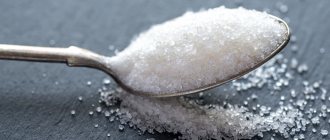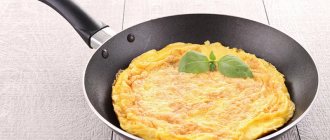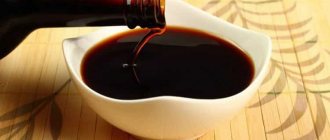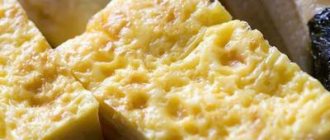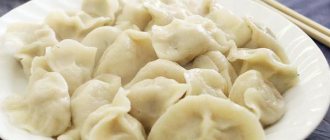Author: Kristina Lobanovskaya, doctor, practicing nutritionist Article updated: 11/09/2020
Capelin, or uyok, is a small sea fish from the Smelt family, which is in universal demand and is considered a “national delicacy.” This popularity is due to its very affordable price and excellent taste. Most often, fresh frozen, salted or pickled capelin is found on sale, since fresh capelin can only be purchased near its habitats - in the Arctic, in the north of the Atlantic and Pacific Oceans, or in the North Atlantic. The fat content and nutritional value of fish, like any other, largely depends on the time of catching. Accordingly, autumn capelin has an average calorie content of 217 kcal, while spring capelin has only 116 kcal per 100 grams. In addition, this parameter is significantly influenced by the method of preparation and the nutritional value of additional components of the dish.
Fresh
Capelin is one of the products that form the basis of the Japanese diet. As you know, this nation is famous for its proper nutrition, which provides them with good health and active longevity. In the Japanese menu, such fish is a source of basic vital substances - vitamins, minerals, protein, beta-carotene and polyunsaturated fatty acids. Fish protein differs from meat protein in having fewer connective fibers, which ensures easy digestibility and rapid digestion. In addition, in terms of its calorie content, capelin corresponds to the most dietary types of meat, and compared to fatty types, it contains 2–3 times less calories. Therefore, it is recommended to be used as a healthy alternative to most meat products during weight loss or to maintain weight.
Fish protein contains the same set of essential amino acids, including taurine, which provides prevention of cardiovascular diseases and nervous disorders. Another undoubted advantage of this fish is its high content of polyunsaturated fatty acids. These active compounds have powerful beneficial effects on the body:
- support heart health;
- optimize nervous activity;
- provide visual acuity;
- reduce the level of “bad” cholesterol;
- reduce the likelihood of developing tumors;
- increase energy and performance.
Among the fatty acids contained in fish oil, linoleic and archidonic acids are separately distinguished, which are components of all cell membranes and brain cells. Therefore, despite the increased fat content and, accordingly, calorie content of capelin caught in the autumn, it is considered the most beneficial for the central nervous system and human health in general.
In addition, this small fish contains a rich range of vitamins and minerals, thanks to which, with regular consumption, it is possible to achieve a number of positive results, including:
- normalization of the digestive system;
- improvement of the thyroid gland;
- removal of inflammatory processes;
- restoration of the balance of vitamins, proteins, unsaturated acids;
- stabilization of cholesterol and lipid levels;
- restoration of the cardiovascular system;
- reducing the likelihood of heart attacks and strokes;
- increased intellectual activity;
- maintaining visual acuity.
Also, the systematic inclusion of fish dishes in the diet allows you to quickly and effectively lose weight by ensuring long-term saturation in small portions and reducing the total daily calorie intake.
Important! A significant part of the beneficial properties of capelin is due to the fact that it lives exclusively in sea water, which is an excellent disinfectant. For this reason, it is not contaminated with pesticides and heavy metals, and there are no parasites or infections characteristic of freshwater inhabitants.
Thus, harm from this small fish can only be caused by purchasing a low-quality product. Fresh, not frozen carcasses smell of sea water (without a specific fishy smell), they have a smooth shiny surface and transparent eyes. When purchasing fresh frozen products, you need to pay attention to the integrity and absence of excess ice, which indicates repeated freezing. If defrosted, harmful bacteria are activated in fish carcasses, which persist during repeated freezing and can cause poisoning. In addition, when re-frozen, most of the valuable substances are lost and the fish, at a minimum, becomes less healthy.
Capelin benefits and harms for losing weight
One of the main components of capelin is protein. It is quickly and easily absorbed, gives energy, allowing the body to burn internal fat faster.
The fat content in fish is also considerable, but these fats do not turn into excess weight. The body uses them to create an outer layer of lipids, the purpose of which is to protect cells.
When eating this small sea fish, with such a rich chemical composition, the body naturally produces insulin and reduces blood sugar levels.
That is why capelin is an indispensable product for diabetics and people suffering from high blood sugar.
Due to the presence of phosphorus, it has a positive effect on the brain, stimulating its activity. Therefore, fish is recommended for people who engage in mental work.
Fish also contains iodine, which improves the functioning of the thyroid gland.
Canned tuna diet: how much weight can you lose?
Salty
Salted capelin is an even more common and widely available product than fresh or frozen capelin. It is produced in a very wide range, but most often it is lightly salted or smoked. The average length of the carcass is usually 22 cm, and the weight reaches 55–65 g, which makes it very convenient to eat as an independent snack. Moreover, the calorie content of one such fish is only 64-75 kcal or 119-141 kcal, depending on the fishing season and the corresponding fat content.
Lightly salted
During the salting process, the chemical composition of the fish does not change - it remains the same rich set of vitamins, minerals and other valuable biologically active substances. For this reason, lightly salted products are considered not only tasty and affordable, but also a very useful component of a healthy diet. However, under the influence of salt, fish flesh becomes somewhat denser and releases moisture, so during the salting process its initial calorie content increases to 156-257 kcal/100 g.
Important! When introducing salty foods into your diet, you must be careful, since they contain a high amount of salt. Excessive consumption of even lightly salted fish can lead to swelling or exacerbation of chronic gastrointestinal diseases.
In addition, industrial products may contain various chemical additives that negatively affect human health. Therefore, it is best to salt this small fish at home. Such a product will have a completely natural composition, excellent taste and consumer characteristics.
Smoked
Smoked capelin is the same salted fish, but additionally processed by cold smoking. This budget snack is often used in combination with beer, and also as a component for preparing a variety of salads, which acquire additional flavor notes with this additive. It should be taken into account that, compared to ordinary lightly salted smoked capelin, the calorie content increases to 169–270 kcal/100 g, since with any smoking technology it dries out a little.
As a rule, all smoked fish is produced on an industrial scale in two ways:
- natural smoke treatment;
- impregnation with a special substance - “liquid smoke”.
In both versions, it acquires not only a characteristic aroma, but also some harmful properties. So, in the first case, saturation occurs with carcinogens contained in combustion products. However, most modern industries use special technologies for purifying smoke from such elements. Therefore, contrary to popular belief, home-smoked fish is often more harmful than store-bought fish.
If we compare liquid smoke with traditional smoking, the liquid concentrate does not have these carcinogenic components. At the same time, it has other properties that are unsafe for humans, especially if there is a tendency to allergies. In any case, you need to consume smoked products very moderately and not too often, since this is not only harmful to health, but can also ruin your figure, adding 100-200 kcal to the daily calorie intake.
When choosing, keep in mind that high-quality smoked fish has a uniform golden color and smooth, dry skin without dark spots or dents. Various damages indicate non-compliance with storage or transportation conditions, as well as staleness of the product.
Important! A sign of proper natural smoking of fish is a golden hue on the surface, the absence of excess moisture and the presence of a hole from the rope. In addition, high-quality smoked capelin has meat tightly attached to the bones, and there are no light spots on the skin, which indicate that it has not been smoked.
Most of all, this product is valued for its high gastronomic characteristics and the absence of significant harm to human health. It contains the highest amount of easily digestible proteins and retains all the important amino acids present in raw fish pulp.
Caviar
Salted products traditionally made from fish include canned caviar. The most famous product in this category on the Russian market is caviar from, which is available in several versions - classic, gourmet, smoked, as well as with salmon, shrimp and other additives. Depending on the proportions used in the finished product, the calorie content of capelin caviar varies slightly and on average is:
- for the delicacy “Lux” – 144 kcal/100 g;
- for delicacy smoked - 190 kcal/100 g;
- for the classic one – 365 kcal/100 g;
- with salmon – 367 kcal/100 g;
- with shrimp – 372 kcal/100 g;
- for smoked – 382 kcal/100 g;
- for a delicacy with shrimp – 410 kcal/100 g.
The composition of such caviar, in addition to the main components, includes vegetable oil, salt, sugar, stabilizers, flavors, acidity regulators and preservatives. But such a set is typical for any canned food of this type, so it is not recommended to introduce them into the diet too often.
Pie in the oven
Small fish in pies is a real hit at holiday feasts! Don't be afraid of bones: after heat treatment, capelin bones are not felt at all.
Step-by-step cooking instructions:
- to bake a pie, you can knead the yeast dough yourself or purchase the finished product at the nearest culinary store;
- rinse the fish thoroughly, remove heads, fins, tails;
- cut the onion into half rings / fry in vegetable oil;
- start the pie: place the circle of dough in a greased pan, make sides. Let the workpiece stand in a warm place for 20 minutes;
- Place the fish and onions on the dough and cover with a second layer of dough. Pinch the edges and prick the pie with a fork to release steam;
- To form a beautiful crust, grease the pie with strong tea leaves;
- bake the festive masterpiece in the oven (180 degrees) for half an hour (until golden brown).
Ingredients (one serving/g):
- wheat flour: 65;
- dry yeast: 0.7;
- milk: 12.5;
- vegetable oil: 7;
- one chicken egg;
- seafood: 100;
- onion: one medium onion;
- salt, sugar and spices: to taste.
Calorie content of 100 g of food: 197 kcal. BJU: 9/7/26
Pickled
Marinated capelin is considered one of the most delicious and healthy fish dishes. It can be purchased ready-made at almost any grocery store or simply and quickly prepared in your own kitchen. This product is most often consumed as an independent snack or in combination with vegetables and a side dish of potatoes.
Excellent taste and consumer qualities make this fish a universal component of almost any diet. In addition, the calorie content of capelin does not change during the pickling process and corresponds to this indicator for fresh capelin - from 116 to 217 kcal/100 g, depending on the fishing season.
In pickled capelin, the valuable substances and beneficial properties of fresh raw materials are completely preserved. The advantage of cooking it yourself is that you can choose spices and seasonings as you wish, giving the finished product the necessary aromatic notes. In addition, marinating at home guarantees the absolute naturalness of the composition, high quality and freshness of the finished dish.
To prepare it, gutted and headless carcasses are placed in a bowl, sprinkled with onion rings, and then poured with marinade. The marinade is boiled by adding 1 tsp to 400 ml of boiling water. sugar, 2 tsp. salt and 4 tsp. vinegar, as well as bay leaf, pepper and other spices. The marinated fish is left in the refrigerator for 10–12 hours. After this time, it will be ready for use.
Minerals
Fish is very rich in potassium , in 100 g of product its amount is more than the daily norm (290 mg when the norm is 200-240 mg). Potassium is necessary to maintain water-salt and acid-base balance. It is involved in the transmission of nerve impulses and oxygen to the brain, has a beneficial effect on the nervous system, the state of brain activity and memory. Potassium is necessary for kidney function, intestinal motility, and heart function depends on it. This macronutrient strengthens the heart muscle, normalizes heartbeat and blood pressure.
Dishes
In cooking, capelin of all types is very actively used - from fresh frozen to smoked. In this case, the recommendations of specialists regarding the use of certain dishes must be taken into account: frozen fish products can be introduced into the diet every day, and smoked and salted ones - only occasionally. It is also important to consider that the relatively low calorie content of capelin can increase significantly when using too nutritious additional components or heat treatment with a large amount of fat.
Boiled
The most suitable food for nutrition during the period of weight loss is boiled capelin with a calorie content of only 121 kcal per 100 grams. This dish is prepared by steaming, in water and even in black tea. In any case, several rules must be followed:
- You need to cook this fish over low heat at a low simmer with the lid closed for no more than 5 minutes;
- To ensure that the carcasses retain their shape as much as possible, sprinkle them with coarse salt half an hour before cooking, and then wash them thoroughly and prepare them using the chosen method;
- It is not recommended to use too many additional ingredients during the cooking process, as the characteristic fishy taste will become less intense.
Important! When boiling fish carcasses in water, it is recommended to add 1-2 black tea bags to the boiling water. Thanks to the presence of tannins and coloring substances, boiled capelin turns out to be denser in structure and acquires a beautiful golden color.
This fish is eaten as an independent snack with tomato or cream cheese sauce, as well as with vegetables, herbs or any side dish. It is important to take into account that the calorie content of the dish will largely depend on the nutritional value of these additives.
Fried
Fried fish is considered the most delicious and aromatic, but at the same time the highest in calories. Since frying involves the use of vegetable oil, the fish pulp, like a sponge, absorbs it, and due to the increase in the amount of fat in the composition, the number of calories also increases. Therefore, compared to boiled fried capelin, the calorie content increases to 194–274 kcal/100 g, depending on the initial energy value. It should be borne in mind that in fattier fish, during frying, the calorie content increases less, since it not only absorbs oil, but also gives off its own fat, which melts under the influence of high temperature.
Before frying, freshly frozen carcasses are defrosted in cold water, washed, placed in a deep plate, salted and gently mixed. Then each fish is rolled in flour and fried in a frying pan with hot vegetable oil. If there is a lot of fish, add oil as needed. Fry until cooked on both sides to form a golden crust. Serve the dish on its own or with any side dish.
Stewed
It is easiest to stew small fish, because with this method of cooking it turns out tastier than boiled and healthier than fried. Tomato sauce is most often used for stewing, which produces a dish that resembles sprat in tomato and has a calorie content of 137–238 kcal/100 g.
To prepare 350 g of capelin, defrost, cut off the fins, head and tail, remove the giblets and wash thoroughly in cold water. Heat 5 tbsp in a frying pan. l. vegetable fat, add the whole fish and fry over medium heat for several minutes, stirring occasionally. Add 4 tbsp. l. tomato paste, salt to taste, mix and simmer over low heat for half an hour, stirring as necessary.
If you wish, before putting the capelin in a frying pan, first fry the onion cut into half rings in the specified amount of oil, and add tomato paste at the end of the stew. The result will be a dish with a slightly different taste and lower calorie content - 100 grams of such a product will contain 126–227 kcal.
Baked
In order to somewhat reduce the cooking time, especially compared to the very long process of frying such small fish, it is baked in the oven. To do this, the carcasses are washed, dried with a napkin, salted and peppered. Pour 3 tbsp into a plastic bag. l. flour, place the fish there, tie it and shake it well. This method helps to significantly speed up the process of rolling in flour.
The baking tray is covered with baking paper, greased with vegetable oil, and the carcasses rolled in flour are laid out. Bake in the oven, preheated to 180ºC for 20 minutes. Then take out the baking sheet, grease the fish with vegetable oil, put it back in the oven and bake for another 10 minutes. With this cooking option, the calorie content of baked capelin will be 165–214 kcal/100 g.
Spicy salting
To salt fish at home and get tasty and healthy capelin with only 59 kcal/100 g of calories, you will need a minimum of time and products. To do this, first boil the brine. Pour 1 liter of water into the pan, add 1 tbsp. l. salt, 1 tsp. sugar, a pinch of allspice, cloves and coriander. Bring to a boil, turn off and let cool.
Place 1 bunch of dill on the bottom of a deep bowl, and 1 kg of fish carcasses on it in an even layer. Pour in cooled brine and press down with a plate. Leave in the refrigerator for 12–14 hours. The fish turns out tender and spicy, there is not much salt in it and there are no additives, so it is much healthier than store-bought. Use it as a stand-alone snack or as part of complex dishes.
Storage and defrosting
It is recommended to store capelin thoroughly washed, gutted, dried and placed in vacuum packaging. In this form, the product is stored in the freezer for 3 months, in the refrigerator at +4° C - about a couple of weeks.
If you don’t have vacuum packaging, then you shouldn’t leave defrosted fish for more than a day, even in the refrigerator.
In this case, the fish should be defrosted in cold water, or even in the refrigerator, but in no case in the open air or in hot water, because during defrosting, pathogenic bacteria will begin to “multiply and multiply” in the capelin. Which, of course, is extremely undesirable.
The nutritional value
Excellent beneficial properties, high nutritional value and moderate calorie content of capelin are optimal for dietary, medicinal and healthy balanced nutrition. Its benefits are explained by the presence of record amounts of certain vitamins, minerals and other valuable elements. Moreover, there are more of some of them in this fish than in meat, while almost a quarter of it consists of higher quality and easily digestible animal protein. Thanks to this composition, eating even small portions of this fish ensures quick satiety and a long-lasting feeling of fullness, which is especially important during the period of weight loss.
Proteins fats carbohydrates
Any fatty sea fish is a rich source of valuable protein and healthy fat. At the same time, the amount of proteins remains practically unchanged, regardless of the calorie content of capelin, and lipids vary significantly depending on the fishing season and processing method, significantly influencing this parameter.
Thus, fresh autumn capelin with a calorie content of 217 kcal per 100 grams contains:
- proteins – 13.6 g;
- fat – 18.1 g;
- carbohydrates – 0 g.
Fresh spring capelin contains 116 kcal/100 g of calories:
- proteins – 13.1 g;
- fat – 7.1 g;
- carbohydrates – 0 g.
Lightly salted capelin contains 257 kcal/100 g of calories:
- proteins – 16.1 g;
- fat - 23.1 g;
- carbohydrates – 0 g.
In smoked capelin, calorie content is 270 kcal/100 g:
- proteins – 18 g;
- fat – 22 g;
- carbohydrates – 0 g.
In pickled capelin, calorie content is 217 kcal/100 g:
- proteins – 13.6 g;
- fat – 18.1 g;
- carbohydrates – 0 g.
Boiled capelin contains 121 kcal/100 g of calories:
- proteins – 13.2 g;
- fat – 15.1 g;
- carbohydrates - 0 g.
Capelin caviar contains 365 kcal/100 g of calories:
- proteins – 8.1;
- fat – 38.6 g;
- carbohydrates – 0 g.
What makes capelin unique in its properties and calorie content is the presence of essential amino acids contained in it in unprecedented quantities. Just 1 serving of this fish product satisfies the daily need for amino acids (tryptophan, lysine, methionine), which are extremely important for normal life. In addition, its pulp contains taurine, which is involved in the regulation of sugar and is inherently an insulin inhibitor. Taurine also helps normalize blood pressure and prevents the development of hypertension.
Fish oil compares favorably with other animal fats. It contains 3 times less cholesterol and much more healthy fatty acids, making it easier to digest and not stored in reserves, and also has a complex of therapeutic effects. In addition, this sea fish contains absolutely no carbohydrates, and the calorie content directly depends on the amount of protein and fat.
Macro- and microelements
Like all seafood, sea fish contains a whole range of macro- and microelements. Therefore, its regular inclusion in the diet has a beneficial effect on the condition of the musculoskeletal system, nervous and nutritional systems, and the whole organism as a whole. At the same time, the list of macroelements is represented by all the main minerals that provide the following beneficial effects:
- potassium - restores the correct rhythm of the heartbeat, ensures proper functioning of the heart muscle and other muscles, increases the strength and elasticity of blood vessels, produces a diuretic effect, accelerates the excretion of bile, improves the transmission of nerve impulses;
- magnesium - normalizes glucose metabolism and protein formation, supports neuromuscular function, reduces the likelihood of stroke, diabetes and other cardiovascular pathologies, relieves headaches, optimizes brain function, improves mood;
- sodium - neutralizes acids, regulates the exchange of water and salt, normalizes blood pressure and other fluids, restores heart rhythm, increases tissue endurance, improves kidney function, generates optimal nerve signals;
- calcium - is responsible for the proper development and strength of bone tissue, activates metabolism, promotes the health of the vascular-cardiac system, normalizes blood pressure, helps remove decay products, improves the processes of formation of blood clots to block the sites of rupture of blood vessels when damaged;
- sulfur - stimulates nervous activity, improves the production of hormones, enzymes, amino acids and vitamins, maintains oxygen balance, has anti-inflammatory and antiallergic effects, normalizes sugar levels, normalizes the condition of the joint and ligamentous apparatus;
- phosphorus - catalyzes a number of important enzymatic reactions, regulates the functioning of hormones, optimizes higher nervous activity, ensures the normal condition of bones and teeth, participates in the formation of neurons, is necessary for energy transfer, improves digestion, helps the liver;
- chlorine - increases the secretion of gastric juice, activates digestive activity, promotes the removal of carbon dioxide and cleanses of toxins, improves the formation of red blood cells, ensures the creation of stable osmotic pressure and regulates water-salt metabolism.
Also, capelin contains a wide range of microelements. Despite the insignificant need for such substances, they are all extremely important for the normal functioning of the human body, since they have a wide range of beneficial properties:
- zinc - produces an immunomodulatory effect, normalizes the formation of bone tissue, protects muscle fibers from destruction, strengthens teeth, improves brain activity, restores the functioning of the reproductive system, and forms a healthy hormonal balance;
- copper - activates the production of blood cells, strengthens bone and connective tissue, improves endocrine activity, strengthens the walls of blood vessels, neutralizes free radicals, enhances redox function;
- manganese - reduces the concentration of cholesterol, resists the development of atherosclerosis and blockage of blood vessels, normalizes the formation of bone tissue, protects cells from destruction, strengthens arterial walls, increases resistance to various infections;
- iron - increases the production of certain enzymes, is the main participant in the formation of hemoglobin, prevents premature fatigue, reduces cravings for sweets, speeds up metabolism and the disposal of toxins;
- chromium - activates enzyme function, enhances metabolism, normalizes the production of fatty acids and proteins, regulates the level of “good” cholesterol, restores normal sugar levels, increases insulin productivity, helps eliminate the effects of stress;
- nickel - catalyzes redox reactions, ensures complete absorption of vitamins and other useful substances, promotes normal hematopoiesis, increases insulin activity, supplies oxygen for cellular respiration, and has a beneficial effect on kidney function;
- iodine – ensures the production of thyroid hormones and normalizes the physiology of this gland, regulates energy metabolism and body temperature, accelerates the course of biochemical reactions, activates the metabolism of BJU and a number of vitamins, restores neuropsychic balance;
- selenium - participates in hematopoiesis, produces immunostimulating and antitumor effects, normalizes reproductive function, promotes the formation of proteins, optimizes enzymatic and hormonal activity, produces antimutagenic and radioprotective effects;
- molybdenum - directly regulates oxidative processes, promotes the synthesis of amino acids, removes uric acid and other breakdown products, reduces the risk of gout, improves the microflora of the gastrointestinal tract, strengthens bone tissue and teeth, prevents impotence in men, improves the absorption of nutrients;
- fluorine - prevents the destruction of bones and teeth, normalizes hematopoiesis, increases the absorption of iron, activates metabolism, cleanses the body of radionuclides and heavy metals.
All of these minerals are present in capelin in record quantities. A small portion of dishes made from this fish contains the daily requirement of almost all macro- and microelements necessary for proper metabolism and other internal processes.
Vitamins
The enormous benefits of capelin are due to the presence in the pulp, and especially in the fat, of the most valuable and even some rare vitamins, including:
- C – produces a powerful antioxidant and anti-stress effect, promotes collagen synthesis, strengthens the structure of muscles, bones, blood vessels and all other tissues, reduces the time of damage regeneration, promotes the formation of antibodies and immune cells, improves well-being during illness, reduces intoxication;
- A - heals the heart, strengthens blood arteries, increases the production of “good” cholesterol, is necessary for maintaining visual acuity, activates oxidation and reduction reactions, accelerates metabolism, improves the functionality of cell membranes, inhibits the formation of fatty deposits;
- E - stimulates neuromuscular activity, reduces the consequences of the negative effects of external factors, protects cells from destruction, prevents premature aging of the body, normalizes the condition of the genital area, helps in conceiving a child;
- D − promotes strong bones by increasing the absorption of calcium and phosphorus, prevents the development of depression, restores sleep and emotional balance, suppresses the growth of cancer cells, strengthens the immune system, and supports eye health.
In addition, fish oil contains a special vitamin F in sufficient quantities. In essence, it is a vitamin complex of polyunsaturated fatty acids (including linoleic, linolenic and arachidonic), which have a unique powerful effect on humans:
- produce anticarcinogenic and anti-inflammatory effects;
- provide prevention and treatment of atherosclerosis;
- help get rid of some skin diseases;
- accelerate wound healing;
- strengthen cell membranes;
- support the functioning of the nervous system;
- normalize the condition of the musculoskeletal system;
- prevent the accumulation of “bad” cholesterol;
- relieve allergy symptoms;
- remove excess fluid, eliminating swelling.
In addition to these valuable elements, this sea fish contains a very extensive list of B vitamins. This complex is responsible in the human body for normal nervous activity, complete digestion of food and high-quality absorption of nutrients from food. Of the entire list of B vitamins, fish pulp contains the following:
- B1 - ensures the transmission of nervous excitation between cells, protects against oxidation products, activates carbohydrate metabolism and the functioning of all systems, increases the absorption of vitamins, helps get rid of skin diseases of psychosomatic origin;
- B2 - normalizes the breakdown of biofuels, improves tissue respiration, promotes the reproduction of stress hormones, increases energy production, preserves youthful skin, improves the liver, accelerates the regeneration of mucous membranes, and promotes constant cell renewal;
- B3 - activates the formation of enzymes, stimulates the metabolism of fatty acids, optimizes brain activity, maintains visual acuity, normalizes blood pressure, reduces cholesterol, strengthens the cardiovascular system, produces an anti-carcinogenic effect, stabilizes sugar concentration;
- B6 - activates the excretion of urine, increases the effectiveness of insulin, optimizes nervous activity, accelerates the treatment of skin diseases, accelerates the breakdown of macronutrients, increases concentration, relieves nausea, reduces night cramps and cramps;
- B9 is the main regulator of the emotional and mental state, improves mood, promotes hemoglobin synthesis, normalizes cell division, supports the health of the heart and blood vessels, improves liver function, has a beneficial effect on digestive processes, and promotes the transmission of impulses between neurons.
The specified set and amount of useful substances is usually preserved not only in fresh, but also in lightly salted or smoked capelin. However, not all of it is equally beneficial for human health. It is best to purchase fresh frozen fish and prepare dishes from it yourself, using healthy methods of heat treatment and choosing the right calorie content of the dishes. In addition, it should be borne in mind that any seafood can cause allergies and cause harm in the case of individual intolerance. Also, iodine-rich dishes are contraindicated if the thyroid gland is highly active. In all other cases, it is recommended to include this small but very tasty sea fish in the diet at least twice a week, and even every day when using dietary recipes.
Composition and beneficial properties
Capelin looks like a small, inconspicuous fish, but its vitamin and mineral composition can be envied by large fish, popular for their taste. Capelin has a large amount of potassium, phosphorus, chlorine, sulfur, sodium, calcium, magnesium and other macroelements. Microelements in fish include fluorine, chromium, iodine, cobalt, and molybdenum. Capelin contains vitamins C, A, D, PP, and also contains a full set of B vitamins. It has Omega-3 polyunsaturated fatty acids, which neutralize excess free radicals and help fight strokes, heart attacks, and cancer cells.
Capelin pate
When planning a festive feast, you can experiment with delicacy capelin formats. Very unusual, but always a win-win in such situations, is homemade smoked fish pate.
Step-by-step instruction:
- buy smoked capelin in a store with a good reputation;
- separate the fillet from the bones;
- grind and beat capelin and cream cheese/butter in a blender;
- brush the tender thick mass with lemon juice;
- fry toast or buy ready-made canapés;
- in case of a large feast, serve the pate to the table in a salad bowl (cocotte bowl).
Ingredients (per serving in grams):
- smoked capelin: 140;
- butter: 10;
- cream cheese: 75;
- lemon juice: 25;
- salt and black pepper: to taste.
Calorie content of 100 g of dish: 250 kcal. BJU: 17/19/37
Capelin stewed with onions in a frying pan: secrets and cooking tips
Capelin stewed with onions in a frying pan is a treat that even someone who has had nothing to do with cooking and cooking can easily prepare, the main thing is to know a few very simple secrets.
- For cooking, you should choose a medium-sized fish that is not damaged or has an unpleasant odor. Be sure to check the expiration date of the product, it must be suitable for consumption.
- For stewing, it is best to take fresh capelin, but freshly frozen product is also perfect, the main thing is that it has not been defrosted several times before.
- Defrost freshly frozen seafood for cooking only in a natural way, so the fish will not lose its juiciness and beautiful appearance. To do this, remove the capelin from the freezer to the refrigerator for 5-7 hours (the time depends on the amount of food).
- In order to achieve a pleasant aroma of the dish, before stewing, capelin should be marinated for 1-2 hours in lemon juice with the addition of all kinds of herbs and spices, and sprinkled with fresh herbs before serving.
- When preparing stewed capelin, do not skimp on onions; with them, the treat turns out much tastier, more satisfying and more aromatic.
- Cook a small fish whole, so it retains all the goodness, fat content and juiciness, however, if you plan to serve the dish for a holiday, you can get rid of the entrails and heads, making the treat more convenient to eat.
Capelin soups
Fish soups differ from fish soup by the presence of celery in the recipe. The main advantages of most capelin soups are the speed and ease of preparation. Let's stock up on celery (tuber/stems/greens) and consider the basic technology recommendation.
To prepare soups from small fresh frozen fish, you need to follow the basic rules.
"Stages of the long journey":
- prepare vegetable base: peel and chop potatoes, carrots and onions;
- in a thick-walled cauldron, cook chopped vegetables with the addition of bay leaves, salt and peppercorns;
- rinse the capelin. Remove heads, tails and fins. Five minutes before the potatoes are ready (an indicator of the readiness of most Russian soups), place the fish with the vegetables;
- at the final stage, add finely chopped tomatoes and celery to the soup;
- The soup is ready when the potato slices become soft and the capelin gives all its talents (aroma/taste) to the dish.
Ingredients (one serving per gram):
- fish: 250;
- potatoes: two tubers;
- carrots: one piece;
- onion: one medium onion;
- tomato: 75;
- celery (greens): 10;
- salt and black pepper: to taste.
Calorie content of 100 g of soup: 120 kcal. BJU: 11/12/7
Recipes with capelin caviar
From the delicious capelin caviar, an experienced chef can instantly create a gourmet delight. Capelin caviar is an excellent seafood product, an excellent opportunity to please guests and loved ones.
Lavash roll with capelin caviar and vegetables
Even a novice cook can master lavash rolls with capelin caviar, Chinese cabbage and tomatoes.
Five steps to the heights of culinary excellence:
- prepare all the ingredients: boil the eggs, chop the cucumber and tomatoes, finely chop the cabbage;
- thoroughly mix (beat) chicken yolks, mayonnaise and capelin caviar;
- Place on the pita bread in even layers alternately: Chinese cabbage / egg and caviar soufflé / cucumbers / tomatoes;
- roll up the roll and cut beautifully;
- Serve, garnish with remaining greens.
Ingredients (per serving in grams):
- caviar: 30;
- thin pita bread: one piece;
- cucumbers: one piece;
- egg;
- Chinese cabbage: 100;
- mayonnaise: 20;
- tomatoes: one piece;
- salt and black pepper: to taste.
Calorie content of 100 grams of product: 150 kcal. BJU: 21/11/9
Eggs stuffed with capelin caviar
When guests knock on the front door, and the kitchen is “neither steamed nor boiled,” it’s time to stuff chicken eggs with capelin caviar.
Step by step express:
- boil, cool, peel and cut chicken eggs into halves;
- Mix caviar, yolks, finely grated cucumber, finely shredded Chinese cabbage and mayonnaise into an evenly weighted mass;
- stuff and decorate egg halves;
- serve and accept congratulations.
Ingredients (dish serving / g):
- caviar: 40;
- cucumbers: one piece;
- one chicken egg;
- Chinese cabbage: 100;
- mayonnaise: 20;
- salt and black pepper: to taste.
Calorie content of 100 grams of product: 130 kcal. BJU: 12/19/8
Boiled capelin (dietary)
The easiest and healthiest approach to small fish is steaming. With the addition of lemon juice and ground black pepper, the delicacy becomes even tastier.
Instructions:
- salt the washed fish and sprinkle the carcasses ready for heat treatment with lemon juice;
- Grease the grill of a multicooker or steamer with vegetable oil;
- for final spice and aroma, you can cover the fish with lemon slices (alternatively, sprinkle with herbs);
- half an hour of steaming is quite enough for capelin.
Ingredients (per serving in grams):
- fish: 200;
- onion: one medium onion;
- lemon juice: 30;
- spicy herbs: 50;
- salt and spices: to taste.
Calorie content 100 gr. dishes: 137 kcal. BJU: 9/7/0.
Grilled capelin
Grilled capelin with the aroma of garlic and spicy citrus notes is a good country treat for those who know a lot about cooking. Golden crust and fresh herbs: everyone will be delighted.
Recommendations from grill masters:
- One of the most important grill secrets is the aromatic dressing. Mix finely chopped garlic, parsley (cilantro), lemon zest and juice in olive oil;
- prepare fish for grilling: rinse, remove heads, salt and pepper;
- place the prepared fish in a strong plastic bag / pour the dressing into the fish / shake rhythmically and for a long time. The purpose of this stage is to marinate the product evenly;
- further without further ado: place the fish on the grill and bake over coals until cooked. Small fish reach condition almost instantly!
Ingredients (serving/grams):
- seafood: 200;
- garlic: one clove;
- lemon zest: 15;
- lemon juice: 35;
- onion: one medium onion;
- parsley: 10;
- olive oil: 45;
- salt and black pepper: to taste.
Calorie content of 100 grams of dish: 165 kcal. BJU: 17/19/12
